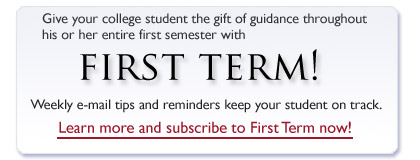There are many kinds of conversations that you need to have with your college student. Some conversations come easily, and at other times it’s a struggle to get your student to make time and/or to participate in the conversation. Some students share readily and others seem to resist our attempts to communicate.
Are you listening?
One of the first questions we, as parents, need to ask ourselves is how much we are actually listening to our students? Do we see these important conversations as simply opportunities to give our opinion? Is our definition of a ”conversation” too one-sided? We may ask for reactions or opinions, or for students to share information, but do we actually listen to what they say? If we aren’t listening, are we surprised that they are less willing to share?
We’ve written some earlier posts about the importance of listening to your college student, and about some good habits to develop as a listener. If you want to hear more from your student, these earlier posts may help you get started.
OK, you’re listening, but how?
What we’d like to consider in this post is not whether you are listening, or even whether you are listening well, but how you listen. What’s your listening position? What’s your attitude as you listen? Not all conversations call for the same type of listening. We actually need to listen differently depending on the subject or the situation.
Leading sound expert Julian Treasure suggests three different ”listening positions,” and we think they are worth considering as you think about conversations with your student. Think of each of these as a sort of tuning dial. You won’t necessarily be at one extreme end of the spectrum or the other, but you might move each dial a bit one direction or the other in order to engage in the type of listening, or listening position, best suited for each conversation.
Active/Passive listening
Good listening takes effort. But some kinds of listening require more effort than others.
Active listening takes work and requires that you put in the effort. Listening actively means that you give deliberate attention and focus to the other person. You listen to understand what is being said and to let the speaker know that he has been heard. While listening actively you might nod, ask questions, summarize, clarify something you don’t understand and respond.
Passive listening does not require much effort. It is the kind of listening that we do when we listen to music or have the TV or radio on in the background. We’re listening, but the listening does not require any interaction or response from us. Passive listening is important and can be appropriate in certain situations, but doesn’t build much of a relationship with the other person.
Critical/Empathic listening
Critical listening is what Treasure calls ”listening for the gold.” As we listen critically, we listen to evaluate what we hear, to gauge the value of the information, to separate out facts and opinion and to form our own opinion of what we hear. It is the kind of listening that we might do in an interview or as we listen to a debate or lecture or to gather facts to solve a problem.
Empathic listening is intended to support the speaker’s feelings and to help them feel safe, open up and share freely without any judgment on the part of the listener. As an empathic listener, your role is to show your student that you are in tune with them, that they are valued and respected.
Obviously, there are times when we need to listen critically to evaluate what our student is telling us, but are there also times when we just need to let our student know that we hear them and resonate with their feelings?
Reductive/Expansive listening
Reductive listening is listening for the bottom line. We want the speaker to get to the point and let us know what’s needed. We listen to find the solution, fix the problem and move on. This is listening that is results oriented. It’s an important type of listening, but can leave our student feeling frustrated or unappreciated if we are too anxious to get to that bottom line.
Expansive listening is listening with someone. In this type of listening, the listening itself is the journey. It is the point. This is creative listening, chatting for the sake of connection, brainstorming or listening without an agenda. Expansive listening may do nothing more than help create trust and goodwill between communicators. Of course, expansive listening may take more time than reductive listening, so we need to be prepared.
Make your dials flexible
Keeping your listening positions in line with the needs of the conversation will open up new ways of communicating with your student. Remember that these are dials, not on/off switches. You’ll move the dial a bit one way or the other. If your student is looking for an analysis of a problem and a solution, they don’t need empathic listening right then. They need you to be active, critical and reductive. Help your student solve their problem. But if your student wants to vent and needs to share, then it’s important that you’re ready and able to listen empathically and expansively. Knowing where to place your dial can make the difference in how the conversation goes.
As a listener, you have more control over the conversation than you realize, even though you may not say a word. Naturally, you may already do much of this without even realizing it, but thinking consciously about employing different listening approaches may enhance your communication – and may encourage your student to share more.
Experiment with your dials and see what you hear.
Related Posts:
Communicating With Your College Student: Are You Listening?
Twelve Things You Can Do to Help You Listen to Your Student
Two Habits That Will Make Your College Student Stop Listening to You
Helping Your College Student Avoid “How Do I Tell My Parents?” Fears




